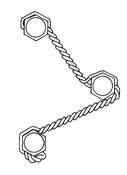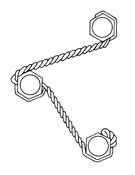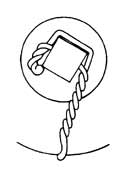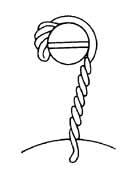|

OK. You’ve finished twisting and turning. Now what?
That’s easy. Cut off the excess length (the excess length
is often called the “pigtail” or “tab”).
The idea is to leave approximately 0.500-inch of twisted wire
sticking out on the back-side of the last bolt or fastener.
With a set of pliers, bend this material back onto itself,
forming a loop (hence the term “pigtail”). You
want the rounded portion of the loop to be what comes in contact
with your hands, clothing or whatever. Let’s just say
the rounded pigtail is less band-aid dependent than a raw
edge of twisted safety wire.
AIRCRAFT PRACTICES…
The aircraft industry is full of established methods of making
things work. What follows is a look at how to correctly safety
wire fasteners, using proven techniques:
 |
 |
 |
 |
| Illustration 1 |
Illustration 2 |
Illustration 3 |
Illustration 4 |
Illustrations 1, 2, 3 and 4 apply to all types of bolts,
fillister head screws, square head plugs and other similar
parts that are wired together. The idea in each of these cases
is to insure that the loosening tendency of either part in
counteracted by the tightening of the other part. According
to the Standard Aviation Maintenance Handbook: “The
direction of twist from the second to the third unit is counterclockwise
to keep the loop in position against the head of the bolt.
The wire entering the hole in the third unit will be the lower
wire and by making a counterclockwise twist after it leaves
the hole, the loop will be secured in place around the head
of that bolt.”
 |
 |
 |
 |
| Illustration 5 |
Illustration 6 |
Illustration 7 |
Illustration 8 |
Illustrations 5, 6, 7 and 8 show the accepted aircraft methods
for wiring various standard items. In these examples the wire
may be wrapped over the unit rather than around it, particularly
when wiring castellated nuts or other items where a clearance
problem may exist.
 |
| Illustration 9 |
Illustration Number 9 is different. It shows the correct
procedure for safety wiring bolts in different planes. As
with other safety-wiring tasks, the wire should always be
applied so that the tension is in the direction of tightening.
Illustration Number 9, shows the method used for hollow head
plugs. As pointed out previously, the “pigtail”
or tab should be bent inside the hole to avoid snags and possible
injury to anyone working on the car.
 |
| Illustration 10 |
If you have a group of fasteners that are closely spaced
they can be wired together, as shown in Illustration 10. With
this many components safetied with one wire, there is a possibility
for loosening. As a result, the aircraft industry has a rule
of thumb for such a group of fasteners. It states you should
limit the number of units that may be wired with a piece of
wire 24-inches long.
| Source |
Mr. Gasket
Performance Group
10601 Memphis Avenue, #12
Cleveland, OH 44144
PH: 216-658-6274
|
One final tip when it comes to safety wire: Think about carrying
a mechanic’s magnet with you when safety wiring pieces
together. Why? Simple. Cut-off wire from the pigtail ends
has a nasty habit of ending up in places it shouldn’t
be – and that includes tires. Remember, the pigtail
cut-offs are sharp!

|
